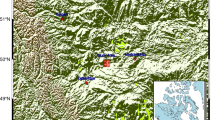Abstract
Various seepage problems such as uplift pressure and high exit gradient lead to less efficient hydraulic structures since aims of the hydraulic design are substantial to be achieved. Cutoff walls and aprons are effective implements to control the problematic consequences of seepage flow. This paper presents a novel methodology for optimal design of cutoff walls and apron beneath Yusufkand diversion dam in Iran based on Non-dominated Sorting Genetic Algorithms-ΙΙ (NSGA-ΙΙ) multi-objective optimization model, Multi-Layer Perceptron (MLP) neural network model and Young Conflict Resolution Theory (YCRT). First, input–output data of a simulation model of seepage flow through the foundation of an existing diversion dam using Geostudio software are utilized to train and validate the MLP neural network, which can model the hydraulic performance of cutoff walls and the upstream apron. Then, the validated MLP neural network models are linked to NSGA-ΙΙ multi-objective optimization model and a trade-off curve is acquired among the hydraulic and cost criteria. Finally, YCRT is used to find the compromise optimal solution on the Pareto-front. Results show that by increasing length of the apron, when cutoff walls are at their minimum depth, the reduction of 18, 14 and 17% have been resulted in vertical exit gradient, uplift force and seepage flow discharge, respectively. Conversely, the same increment in length of the apron caused 2, 0 and 2% reduction in the mentioned parameters when other two cutoff walls are at their maximum depth. Moreover, the construction cost pertained to 1 meter of cutoff wall is nearly twice as much as for 1 meter of apron.










Similar content being viewed by others
References
Abdul Kareem Esmat Z (2011) The effect of cutoff wall angle on seepage under dams. J Eng 17:1109–1131
Al-Suhaili RH, Karim RA (2014) Optimal dimensions of small hydraulic structure cut-offs using coupled Genetic Algorithm and ANN models. J Eng 20:1–19
Azizi S, Salmasi F, Abbaspour A, Arvanaghi H (2012) Weep hole and cut-off effect in decreasing of uplift pressure (Case study: Yusefkand Mahabad diversion dam). J Civ Eng Urban 2:97–101
Bazargan-Lari MR, Kerachian R (2008) Developing a conflict resolution model for groundwater quantity and quality management: a case study. World Environmental and Water Resources Congress 2008: Ahupua’A, pp 1–10
Bazargan-Lari MR, Kerachian R, Mansoori A (2009) A conflict-resolution model for the conjunctive use of surface and groundwater resources that considers water-quality issues: a case study. Environ Manag 43:470–482
Bazargan-Lari MR, Kerachian R, Sedghi H, Fallahnia M, Abed-Elmdoust A, Nikoo MR (2011) Developing probabilistic operating rules for real-time conjunctive use of surface and groundwater resources: application of support vector machines. J Water Wastewater 76:54–69
Deb K, Pratap A, Agarwal S, Meyarivan T (2002) A fast and elitist multiobjective genetic algorithm: NSGA-II. IEEE Trans J Evol Comput 6:182–197
Doan C, Liong S (2004) Generalization for multilayer neural network bayesian regularization or early stopping. In: Proceedings of Asia Pacific Association of Hydrology and Water Resources 2nd Conference, pp 5–8
Fallah-Mehdipour E, Haddad OB, Beygi S, Mariño MA (2011) Effect of utility function curvature of Young’s bargaining method on the design of WDNs. Water Resour Manag 25:2197–2218
Farouk MI, Smith IM (2000) Design of hydraulic structures with two intermediate filters. Appl Math Model 24:779–794
Ghobadian R, Khodaei K (2009) Effects of cutoff wall and drain on uplift pressure and exit gradient under hydraulic structure by numerical solution of general equation of fluid flow in soil using Finite Volume Method (in Persian). J Water Soil 23:148–160
Honar T, Khoramshokooh N, Nikoo MR (2018) Hydraulic optimization of corrugated stilling basin with adverse slope. Water Sci Technol Water Supply. https://doi.org/10.2166/ws.2018.079
Khoramshokooh N, Veiskarami M, Nikoo MR, Pourvahedi Roshandeh S (2018) Multi-objective hydraulic optimization of diversion dam’s cut-off. Water Resour Manag. https://doi.org/10.1007/s11269-018-2015-4
Lodwich A, Rangoni Y, Breuel T (2009) Evaluation of robustness and performance of early stopping rules with multi layer perceptrons. In: International Joint Conference on Neural Networks, IJCNN. IEEE, pp 1877–1884
Madani K (2010) Game theory and water resources. J Hydrol 381:225–238
Moharrami A, Moradi G, Bonab MH, Katebi J, Moharrami G (2015) Performance of cutoff walls under hydraulic structures against uplift pressure and piping phenomenon. Geotech Geol Eng 33:95–103
Napel S (2002) Bilateral bargaining: theory and applications, vol 518. Springer, Berlin
Nikoo MR, Varjavand I, Kerachian R, Pirouz MD, Karimi A (2014) Multi-objective optimum design of double-layer perforated-wall breakwaters: application of NSGA-II and bargaining models. Appl Ocean Res 47:47–52. https://doi.org/10.1016/j.apor.2014.12.001
Nikoo MR, Khorramshokouh N, Monghasemi S (2015) Optimal design of detention rockfill dams using a simulation-based optimization approach with mixed sediment in the flow. Water Resour Manag 29:5469–5488
Niksokhan MH, Kerachian R, Amin P (2009a) A stochastic conflict resolution model for trading pollutant discharge permits in river systems. Environ Monit Assess 154:219–232
Niksokhan MH, Kerachian R, Karamouz M (2009b) A game theoretic approach for trading discharge permits in rivers. Water Sci Technol 60:793–804. https://doi.org/10.2166/wst.2009.394
Parsasadr H, Mohammadzadeh H, Akhtarpur A (2012) Simulation of seepage through the body and foundation of Sabzevar’s Roudab dam with Finite Elements Method using Seep/W software (In Persian). In: 1st congress on geology of Iran plateau, International Center for Science, High Technology and Environmental sciences, Kerman, Iran
Raei E, Nikoo MR, Pourshahabi S (2017) A multi-objective simulation-optimization model for in situ bioremediation of groundwater contamination: application of bargaining theory. J Hydrol 551:407–422
Rafipour-Langeroudi M, Kerachian R, Bazargan-Lari MR (2014) Developing operating rules for conjunctive use of surface and groundwater considering the water quality issues. KSCE J Civ Eng 18:454–461
Shirangi E, Kerachian R, Bajestan MS (2008) A simplified model for reservoir operation considering the water quality issues: application of the Young conflict resolution theory. Environ Monit Assess 146:77–89
USBR (2014) Reclamation Managing Water in West. Embankment Dams: Chapter 8, Seepage 2014 (DS-13(8)-4.1): phase 4 (final), U.S., Department of Interior Bureau of Reclamation (USBR)
Vosoughi AR, Nikoo MR (2015) Maximum fundamental frequency and thermal buckling temperature of laminated composite plates by a new hybrid multi-objective optimization technique. Thin Walled Struct 95:408–415
Xu YS, Shen SL, Du YJ, Chai JC, Horpibulsuk S (2013) Modelling the cutoff behavior of underground structure in multi-aquifer-aquitard groundwater system. Nat Hazards 66:731–748
Young HP (1993) An evolutionary model of bargaining. J Econ Theory 59:145–168
Author information
Authors and Affiliations
Corresponding author
Rights and permissions
About this article
Cite this article
Nikoo, M.R., Gavahi, K. & Khoramshokooh, N. A Multi-objective Simulation–Optimization Approach for Design of Cutoff Walls and Apron of Diversion Dams. Iran J Sci Technol Trans Civ Eng 43, 241–252 (2019). https://doi.org/10.1007/s40996-018-0134-z
Received:
Accepted:
Published:
Issue Date:
DOI: https://doi.org/10.1007/s40996-018-0134-z




